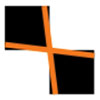
Figure 4.5.a
Source: Akshata Kare (Recreated for academic purpose)
Does the checkerboard look like it is bulging from the middle? This is known as the bulging checkerboard illusion. Akiyoshi Kitaoka created the optical illusion known as The Artifact. The checkerboard, in this instance, appears to swell from the centre, but it is actually just a conventional checkerboard with tiny squares placed at specific intervals to create the illusion.
Why does this illusion take place? Because this uses the Gestalt law of closure, we tend to draw connections between the lines and perceive the squares as off-centre. If we were to see the squares individually, they would appear to be a standard squares, but when we view them collectively, our brains classify them as quadrilaterals, creating the illusion of a "Bulging Checkerboard."
Another explanation provided by the creators is we tend to perceive lines wherever possible. Take a look at the diagram below. This represents two tiles that are connected in the illusion.

Figure 4.5.b
Source: Akshata Kare
However, the interpretation of what we consider the edges of the black square is based on the edges of the white square; therefore, there is a slight misalignment. In the diagram below, the misalignment is shown as the orange lines.

Figure 4.5.c
Source: Akshata Kare
And as the perceived lines are not "straight," we perceive the squares to be slightly tilted.

Figure 4.5.d
Source: Akshata Kare
In each quadrant, this tilt is manipulated by positing the white dots slightly different in us perceiving the board as bulging.
We can use this perceived tilt to our advantage by carefully arranging these tiny compartments throughout the checkerboard to produce illusions like the bulging checkerboard.
Here are more explorations:

Figure 4.5.e
Source: Akshata Kare

Figure 4.5.f
Source: Akshata Kare

Figure 4.5.g
Source: Akshata Kare

Figure 4.5.h
Source: Akshata Kare

Figure 4.5.i
Source: Akshata Kare

Figure 4.5.j
Source: Akshata Kare

Figure 4.5.k
Source: Akshata Kare

Figure 4.5.l
Source: Akshata Kare
Here is a video investigating further explorations of the illusion:
For more explorations and explanations, take a look at the pdf below:
• Bulging Checkerboard......


